|

1860 photo taken 4 days after Mr.
Lincoln visited Lincoln, Illinois, for the last time. Info at 3 below.
This President
grew;
His town does too.
Link to Lincoln:
Lincoln & Logan County Development Partnership
Site
Map
Testimonials
Abraham Lincoln Bicentennial Commission of Lincoln, IL
|
1.
Abraham Lincoln and the Historic Postville
Courthouse,
including a William Maxwell connection to the Postville Courthouse
2.
About Henry Ford and the Postville Courthouse, the
Story of the Postville Courthouse Replica,
Tantivy, & the Postville Park
Neighborhood in the
Route 66 Era
3.
The Rise of Abraham Lincoln and the Founding of Lincoln, Illinois,
also the founding of Lincoln College, the plot to steal Lincoln's
body, and memories of Lincoln College and the Rustic Tavern-Inn
4.
Introduction to the Social & Economic History of
Lincoln, Illinois, including poetry by William Childress
& commentary by Federal Judge Bob Goebel & Illinois Appellate Court
Judge Jim Knecht
5.
"Social Consciousness in William Maxwell's
Writings Based on Lincoln, Illinois" (an article published in the
Journal of the Illinois State Historical Society, winter 2005-06)
5.a.
Peeking Behind the Wizard's Screen: William
Maxwell's Literary Art as Revealed by a Study of the Black Characters in
Billie Dyer and Other Stories
6.
Introduction to the Railroad & Route 66 Heritage
of Lincoln, Illinois
7.
The Living Railroad Heritage of Lincoln, Illinois:
on Track as a Symbol of the "Usable Past"
8.
Route 66 Overview Map of Lincoln with 42 Sites,
Descriptions, & Photos
9.
The Hensons of Business Route 66
10.
The Wilsons of Business
Route 66,
including the Wilson Grocery & Shell Station
11.
Route 66 Map & Photos Showing Lincoln Memorial
Park
(former Chautauqua site),
the Historic Cemeteries, & Nearby Sites
12.
Route 66 Map & Photos Showing Salt Creek &
Cemetery Hill,
including
the highway bridges, GM&O bridge, Madigan State Park, the old dam (with
photos & Leigh's memoir of "shooting the rapids" over the old dam), &
the Ernie Edwards' Pig-Hip Restaurant Museum in Broadwell
13.
The Historic Logan County Courthouse, Past &
Present
14.
Route 66 Map
with 51 Sites in the Business & Courthouse Square Historic District,
including locations of historical markers
(on the National Register of Historic Places)
15.
Vintage Scenes of the Business & Courthouse Square
Historic District
16.
The Foley House: A
Monument to Civic Leadership
(on the National Register of
Historic Places)
17.
Agriculture in
the Route 66 Era
18.
Arts & Entertainment Heritage,
including
the Lincoln Theatre Roy Rogers' Riders Club of the
1950s
19.
Business Heritage
20.
Cars, Trucks & Gas Stations of the Route 66 Era
21.
Churches, including the hometown
churches of Author William Maxwell & Theologian Reinhold Niebuhr
22.
Factories, Past and Present
23.
Food Stores of
the Route 66 Era
24.
Government
25.
Hospitals, Past and Present
26.
Hotels & Restaurants of the Railroad & Route 66
Eras
27.
Lincoln Developmental Center
(Lincoln State School & Colony in
the Route 66 era), plus
debunking the myth of
Lincoln, Illinois, choosing the Asylum over the University of Illinois
28.
Mining Coal, Limestone, & Sand & Gravel; Lincoln Lakes; & Utilities
29.
Museums & Parks, including the Lincoln College
Museum and its Abraham Lincoln Collection, plus the Heritage-in-Flight
Museum
30.
Neighborhoods
with Distinction
31.
News Media in the Route 66 Era
32.
The Odd
Fellows' Children's Home
33.
Schools
34.
Memories of the 1900 Lincoln Community High School,
including Fred Blanford's dramatic account of the lost marble
fountain of youth
35.
A Tribute to the Historians and Advocates of
Lincoln, Illinois
36.
Watering Holes of the Route 66 Era
37.
The Historic 1953 Centennial Celebration of
Lincoln, Illinois
38.
The Festive 2003 Sesqui-centennial Celebration of
Lincoln, Illinois, including photos of LCHS Class of 1960
dignitaries & the Blanfords
39.
Why Did the State Police Raid Lincoln, Illinois,
on October 11, 1950?
40.
The Gambling Raids in Lincoln and Logan County,
Illinois,
During the Late Route 66 Era (1950-1960)
_______
Pages
in this section tell about Leigh Henson's Lincoln years, moving away,
revisits, and career:
About Lincoln, Illinois;
This
Web Site; & Me
A Tribute to Lincolnite Edward Darold
Henson: World War II U.S. Army Veteran of the Battles for Normandy and
the Hedgerows; Brittany and Brest; and the Ardennes (Battle of the
Bulge)
For Remembrance, Understanding, & Fun: Lincoln
Community High School Mid-20th-Century Alums' Internet Community
(a Web site and
email exchange devoted to collaborative memoir and the sharing of photos
related to Lincoln, Illinois)
Directory of Email Addresses of 168 Mid-20th
Century LCHS Alums
Leigh Henson's Pilgrimage to Lincoln, Illinois, on
July 12, 2001
Leigh Henson's
Review of Dr. Burkhardt's William Maxwell Biography
Leigh Henson's Review of Ernie Edwards' biography,
Pig-Hips on Route 66, by William Kaszynski
Teach Local Authors: Considering the Literature of
Lincoln, Illinois
Web Site About
Leigh Henson's Professional Life
__________
Pages
in this section are about the writing, memorabilia, and Web sites of
other Lincolnites:
A
Tribute to Bill and Phyllis Stigall:
Exemplary Faculty of Lincoln College at Mid-Twentieth Century
A
Tribute to the Krotzes of Lincoln, Illinois
A Tribute to Robert Wilson (LCHS '46): Author of
Young in Illinois, Movies Editor of December Magazine,
Friend and Colleague of December Press Publisher Curt Johnson, and
Correspondent with William Maxwell i
Brad Dye (LCHS '60): His Lincoln, Illinois, Web
Site,
including photos of many churches
Dave Armbrust's Memorabilia of Lincoln, Illinois
Leigh Henson's
Review of Dr. Barabara Burkhardt's William Maxwell Biography
Leigh Henson's Review of Ernie Edwards' biography,
Pig-Hips on Route 66, by William Kaszynski
Leigh
Henson's Review of Jan Schumacher's
Glimpses of Lincoln, Illinois
J. Richard
(JR) Fikuart
(LCHS '65):
The
Fikuarts of Lincoln, Illinois, including their
connections to the William Maxwell family and three generations of
family fun at Lincoln Lakes
Jerry Gibson (LCHS '60): Lincoln, Illinois,
Memoirs & Other Stories
Dave Johnson (LCHS '56): His Web Site for the
Lincoln Community High School Class of 1956
Sportswriter David Kindred: Memoir of His
Grandmother Lena & Her West Side Tavern on Sangamon Street in the Route
66 Era
Judge Jim Knecht
(LCHS '62): Memoir and Short Story, "Other People's Money," Set in
Hickey's Billiards on Chicago Street in the Route 66 Era
William A. "Bill" Krueger (LCHS '52): Information
for His Books About Murders in Lincoln
Norm Schroeder (LCHS '60): Short Stories
Stan Stringer Writes About His Family, Mark
Holland, and Lincoln, Illinois
Thomas Walsh: Anecdotes Relating to This Legendary
Attorney from Lincoln by Attorney Fred Blanford & Judge Jim Knecht
A Tribute to Robert Wilson (LCHS '46): Author of
Young in Illinois, Movies Editor of December Magazine,
Friend and Colleague of December Press Publisher Curt Johnson, and
Correspondent with William Maxwell, including excerpts
from Young in Illinois and from Maxwell's letters to Robert;
family photos and information from Robert's only child, Sue Young
Wilson; commentary from Literary Critic Lee Walleck; and memoir by Curt
Johnson
Leon Zeter (LCHS '53): His Web Site for the
Lincoln Community High School Class of 1953,
including announcements of LCHS class reunions
(Post yours there.)
__________
|
|

Highway Sign of
the Times:
1926-1960
The Route 66
Association of Illinois
The Illinois
State Historical Society
Illinois
Tourism Site:
Enjoy Illinois
|
| |
|
Internet Explorer is the
only browser that shows this page the way it was designed. Your
computer's settings may alter the display.
April 24, 2004: Awarded "Best Web Site of the Year" by the Illinois State Historical
Society
"superior
achievement: serves as a model for the profession and reaches a greater
public"
|
|
Marquee
Lights of the Lincoln Theater, est. 1923, Lincoln, Illinois |
|
30. Neighborhoods with Distinction
"Every
street was exceptional. You could not possibly mistake Fifth Street
for Eighth Street . . . or Broadway for Pulaski Street, and no two
houses were exactly alike, either. Some of them were so original that
they always seemed to have something they wanted to say as you walked past:
perhaps no more than this, that the people who lived in them did not wish
they lived in Paris or Rome or even Peoria. What would be the point of
living somewhere you did not know everybody?"
William Maxwell,
Ancestors (1971), p. 189.
"Ninth
Street had the air of having been there since the beginning of time."
William Maxwell, So Long, See You Tomorrow (1980), p. 22.
"In
present-day Lincoln, it is fashionable to live clear out in the country,
surrounded by cornfields."
William Maxwell,
So Long, See You Tomorrow (1980), p. 25.
_____________________
Today
Lincoln, Illinois, offers the widest range of housing options in its history -- whether
apartments close to the "downtown" historic district, traditional neighborhoods, or new
developments in outlying areas.
Lincoln is especially
distinguished by the vintage residences of its traditional neighborhoods.
The rare picture postcards and other images on this page show the glory of 19th- and early-20th-Century houses
in Lincoln. Many of them remain today. For information about
active historic preservation in Lincoln, Illinois, use the link for lincolndailynews.com in Sources Cited below. On that page, scroll to
several articles with photos.
|
|
A Sampling
of the Vintage Houses That Distinguish Lincoln,
Illinois
The images below show examples of various
architectural designs found in Lincoln's vintage houses. These images
do not include all of the architectural styles found in this city, and not
all of the structures shown below have survived.
Yet, many historic homes of various styles may be observed today -- Craftsman, Greek Revival,
Italianate, Second Empire, Spanish, Tudor, and Victorian (specifically, "stick" and
Queen Anne).
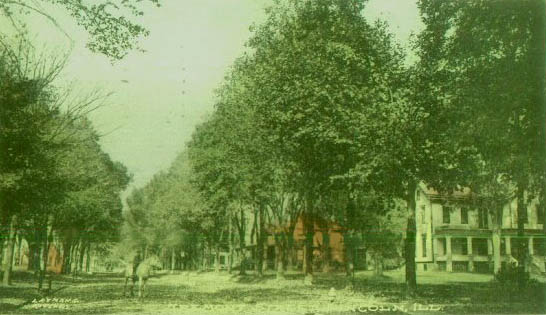
30.1: Colorized Picture
Postcard Showing Rider on White Horse, 1907,
Among Vintage Houses on Tremont Street
|
|
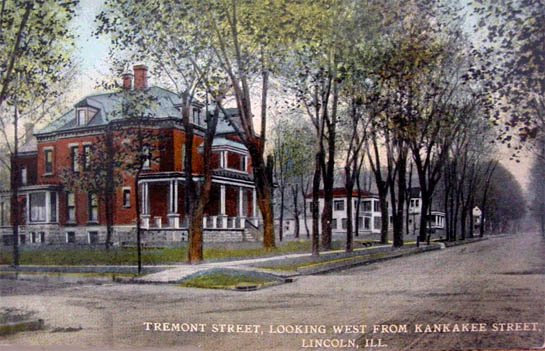
30.2:
Red Brick Home on Picture Postcard, 1910
Ordinarily I have no clue about the ownership of houses seen in vintage
postcards of Lincoln. When I saw the picture postcard above, however, the corner house
looked familiar. I looked at the photos of several older houses
pictured in The Namesake Town: A Centennial History of Lincoln,
Illinois. There on page 39 is a cluster of six photos of houses,
and the one in the lower right corner is clearly the same as the red-brick
house above. The caption of the photo in The Namesake Town says this house had been owned by
James L. Goodnight and Wilbur Gullett.
In response to the above paragraph,
Stu Wyneken writes
(7-03),
"Thought I would let you know that Picture # 30.2: Red Brick Home of
Wilbur Gullett on Picture Postcard, 1910, in the neighborhoods section,
is not a picture of my grandfathers house, but rather a picture of the
Hartnell home which was located directly across the street from my
grandfather's. It was torn down in the late 1920's or early 1930's Three
homes stand on the lot now."
Respond to Stu at
[email protected].
|
|
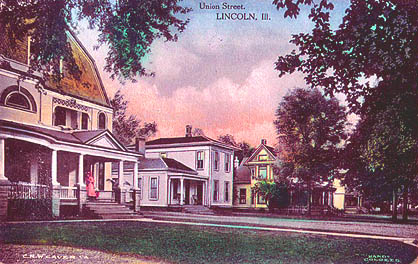
30.3: Colorized Picture
Postcard Showing Union Street in 1910
|
|
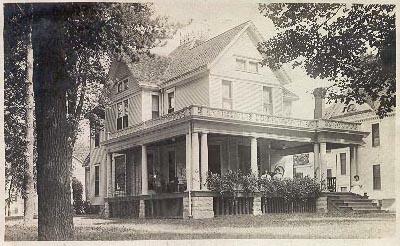
30.4: Picture
Postcard of the Former Fogerty House in 1908
This
house was typical of the grand old houses of the early 20th Century. I
am unsure whether this house has survived into the 21st Century, but many
vintage residences have.
Postmarked
September 14, 1908, this picture postcard was mailed from Lincoln to Miss
Josephine Kelly of Peoria with the following message: "A little
remembrance from some Lincoln friends. Don't forget, Jo,
the interurban comes here now, making a delightful trip. Come over
sometime. Love from all." Signed L.C. Fogerty.
|
|
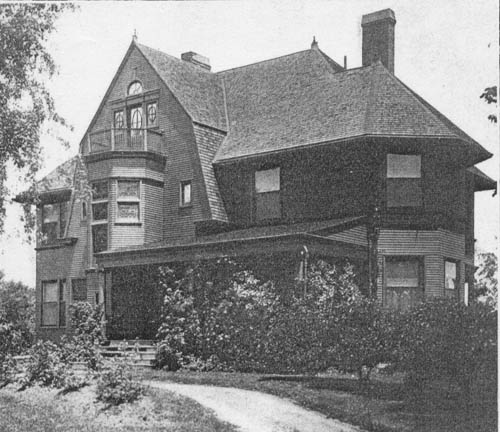
30.5:
The Former John A. Lutz Residence
(Photo from
Fish, Illustrated Lincoln, 1916, no pages used. Fish's book
also has exterior and interior photos of the department store that Mr. Lutz
owned and operated in downtown Lincoln for fifty years. The store had
14,500 square feet of floor space. This house has survived.)
The Lutz house is featured in The Badger Collection Featuring Lincoln of
Illinois, 1987, which presents this description: "Built in 1898 by
John C. and Caroline C. Lutz. . . . the home was completed in time for
the wedding of their daughter Marian to Frank B. Gordon. . . it was built at
a cost of $5,000 on land once owned by Lincoln College. . . Lutz
owned a dry goods, carpet & millinery store at 517-519 Broadway.
Originally of the Shingle style -- 1880 to 1910. . . . identifying
features. . . hipped roof with cross-gambrel roof. . . polygonal tower, wall
extension. . . rearward recessed porch. . . . classical columns support the
front, partial porch. . . . ."
|
|
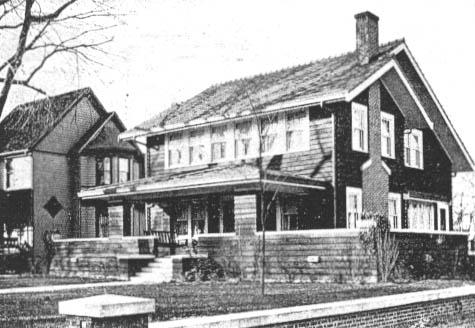
30.6: The Former Residence of F.W.
Becker, First National Bank Cashier
(Photo from Fish, Illustrated Lincoln, 1916. This residence has
survived.)
|
|
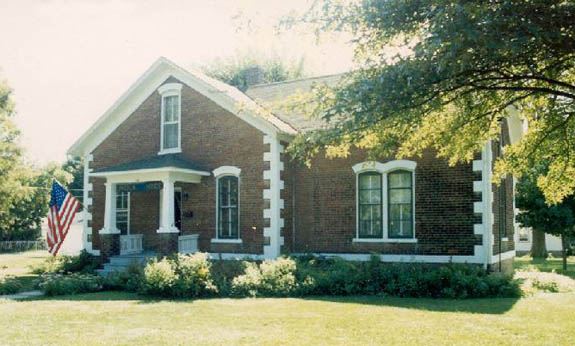
30.7:
The Former William Anderson Home
(Photo provided by Fred Blanford)
"Progress"
has demolished the Anderson house and replaced it with a Subway sandwich
shop.
David Alan
Badger presents an artistic drawing of the Anderson house in his book titled
The Badger Collection Featuring Lincoln of Illinois (no pages used).
Badger offers the following history and description of the architecture:
"Built circa
1890. . . owned by William & Caroline Anderson. . . he came from Glasgow,
Scotland. . . . in 1849, he married Caroline C. Martin from Virginia.
. . . they moved to Logan County in 1864. . . ."
"National
Folk style--1850 to 1890. . . . identifying features. . . gable-front &
wing. . . rusticated quoins. . . paired, segmental arched window. . . ."
|
|
Houses of Lincoln in the Childhood World of William Maxwell
In twelve short stories and five books, William Maxwell refers to various
houses that he knew as a child in Lincoln, mostly in the traditional neighborhoods. (Maxwell was born in 1908 and lived in Lincoln until about 1922.) Below I cite
many of these references, beginning with his parents' and grandparents'
houses and extending to the houses of family acquaintances and others.
Here, my intention in discussing Maxwell's house descriptions is to help
you understand the settings of his works situated in Lincoln, Illinois.
In turn, as you read these works, I hope you will better appreciate the
artistic role of setting in the author's portrayal of the people and culture
of Midwestern towns.
|
|
The Four Homes of William K.
Maxwell, Sr.
Author William Maxwell's father owned
four houses in Lincoln at different times as well as at least two farms in Logan County.
After living in the home of his in-laws, the Edward Blinns, during the first year
of marriage, the author's parents, the William Keepers Maxwells, "bought a modest two-story frame house.
. . , a block from my Grandfather Blinn's. [Aunt] Annette
says that it had eight rooms, but that they were small. My father
wasn't going to make the mistake his father had of living in a house that
was grander than he could afford" (Ancestors, p. 179).
|
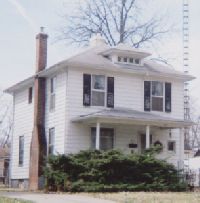
30.8:
Birthplace of
William Maxwell
|
|
In Ancestors,
William Maxwell writes that many years later "walking past it I used to worry that it would not be there when the
time came to put up the plaque. I think I expected to be President of
the United States" (p. 180).
|
|
The second house owned by
William K. Maxwell, Sr., was the celebrated house depicted at right. It is the setting of
his son's novels titled They Came Like
Swallows (1937) and Time Will Darken It (1948), and the house is
referred to in several of his other works, including Ancestors
(1971), a family history. The Maxwells were living
here when the mother, Eva Blossom "Blos" Blinn Maxwell (b. 1889)
succumbed to the Spanish flu on January 3, 1918, two days after giving
birth (in either Decatur or Bloomington, Illinois -- I'm not sure which at
present) to a third son,
Robert Blinn (So Long, See You Tomorrow, p. 7). Mr.
Maxwell soon afterward moved from this house that sadly reminded him of his dead wife,
completely disrupting his sons' lives. Yet, this house held fond memories for William Maxwell.
|
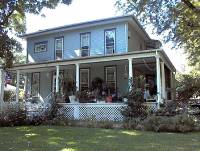
30.9:
Contemporary View of the
Boyhood Home of
William Maxwell
The
house continues as a private residence, and the owners graciously consented to
locating a historical plaque in their yard. Photo is from lincolndailnews.com,
August 17, 2002. Dedication of the commemorative plaque was August 24,
2002. |
|
The Thomas Donalds had
moved next door to the senior William Maxwells (Ancestors, p. 185). William Maxwell wrote that Mrs.
Donald and his mother were best friends for many years ("A Final Report," p.
125). William Maxwell
provides a three-page description of his boyhood home in Ancestors (pp.
185-188). The house had been owned by a prominent Judge Hoblit, who
"went bankrupt." This house was "almost directly across the street
from" the Blinns' house, where Maxwell's mother had grown up, so she was
very familiar with this house before it became her home. She
redecorated the house: "She couldn't
bear dark varnished woodwork, and had it painted white upstairs and down.
In the dining room the walls were dark green and the molding was black,
requiring coat after coat after coat of white enamel. It was the only
resistance the house put up. After that it was hers" (p. 186).
Maxwell writes, "I didn't distinguish between the house and her, any more
than I would have distinguished between her and her clothes or the sound of
her voice or the way she did her hair" (p. 187).
In Ancestors, Maxwell uses a long paragraph to describe the exterior
features of the property: the big yard, the "full-grown trees," "the wide comfortable
porch," the bay window with the bed of lilies of the valley under it, the
dining room window and the "huge white lilac bush" outside of it, the
trumpet vine by the back steps, and the grape arbor (p. 187).
The emotional attachment
Maxwell felt to this home and neighborhood was profound:
"when I was separated from it permanently, the sense of deprivation was of
the kind that exiles know" (p. 187). "During the whole of my childhood
I never thought it or said it or heard it without my heart responding, and
fifty years later it still does -- so much so that it is hard for me to
realize that for other people what the name suggests is probably something
quite ordinary. A quiet, tree-lined street in a small town shortly
before the outbreak of the First World War, is, in any event what it was" (Ancestors,
p. 188). In his
adulthood, Maxwell's infrequent homecomings to Lincoln were not complete without
a walk through his boyhood neighborhood: "When I go home, usually because of a
funeral, I always end up walking down Ninth Street. I give way to it
as if it was a sexual temptation" (So Long, See You Tomorrow, p.
129). The third house of
William Maxwell, Sr., was located in a subdivision that was new
in the 1920s. William Maxwell, Sr., and his second wife, Grace McGrath
Maxwell, built this house soon after their marriage and before the insurance
company he worked for promoted him and transferred him
to Chicago in approximately 1922. This house is part of the setting in So Long, See You
Tomorrow (1980): "My
father and my stepmother had seen a stucco house in Bloomington that they
liked, and they got an architect to copy the exterior and then the three of
them fiddled with the interior plans until they were satisfactory. I
was shown on the blueprints where my room was going to be. In a short
time the cement foundation was poured and the framing was up and you could
see the actual size and shape of the rooms. I used to go there after
school and watch the carpenters hammering: pung, pung, pung, kapung,
kapung, kapung, kapung. . . " (So Long, See You Tomorrow, p.
25). As the house was being constructed, Maxwell and classmate Cletus
Smith played in it together and became friends. Cletus's
father's murder of Lloyd Wilson is the basis of the "creative memoir" titled
So Long, See You Tomorrow.
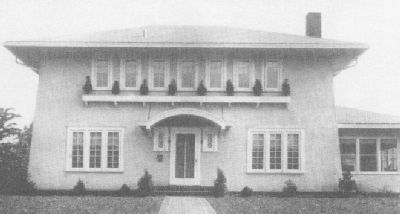
30.10: Home of William and
Grace McGrath Maxwell in 1922
(photo in Burkhardt, William Maxwell: A Literary Life, after p. 170.
See Works Cited for link to more information about this impressive biography.) After
William Maxwell, Sr., had worked in Chicago for twenty years, "a detached retina brought his career to a
premature end. They moved back to Lincoln, to the same street. . . , but a different house" ("The Front and Back Parts of the House", p.
282). This house was the fourth in Lincoln owned by William Maxwell,
Sr.
|
|
The Close Proximity of the
W.K. Maxwells' Home and the Edward Blinns' Home: Maternal Grandparents of
William Maxwell
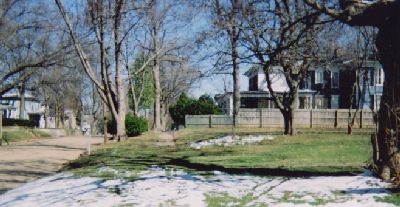
30.11:
Homes of William K. and Blossom Blinn Maxwell, Sr. (far left), and
the Edward Blinns (right)
|
|
Home of the Robert Creighton Maxwells:
Paternal Grandparents of William Maxwell
From Mr. Robert Creighton Maxwell's law practice, he earned a respectable
income, and the family lived in a large house. There, they had challenging expenses. Mr. Maxwell argued
with his wife over her household expenditures when the annual bill came in
January from the A. C. Boyd Dry Goods Store.
|
|
In Ancestors,
Maxwell describes the house of his paternal grandparents: "All Middle
Western houses of that period were dark and gloomy, and I have no reason to
think that the house my grandparents built on Kickapoo Street was an
exception. I used to ride past it sometimes on my bicycle, but I was
never in it. It was large, for that time and that place, with a round
tower on one corner and spiderwebs of carpenter's lace all around and even
under the various porches.
From an old photograph, it appears that the
carpenter's lace and the lace curtains in the bay window were almost
identical. Driving past the house when he was an old man, my father
shook his head and remarked sadly, 'That fretwork cost eighty acres of the
finest land in Logan County'" (Ancestors, p. 144).
|
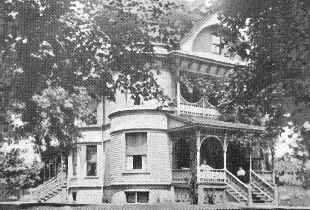
30.12:
The Robert C. Maxwell Home
(Photo from Gleason, p. 187.
This house survives.) |
|
"The house on Kickapoo
Street passed out of the family before I was born [1908], but my Aunt
Annette spent a night there when she was a young woman and was outraged by
an electric bell that rang loudly all through the upstairs when it was time
to get up, and again when it was time to come hurrying to the table, where,
to her surprise, they had steak for breakfast. . . . It has occurred to me
that the electric bell may have served a purpose my Aunt Annette was not
aware of -- that it was a piece of ritual magic, intended to keep disaster
away from the house" (pp. 144-145).
The Robert Creighton
Maxwell house survives and is represented in The Badger Collection
Featuring Lincoln of Illinois with the following account:
"The home of Robert C. &
Margaret Maxwell. . . . Robert was an attorney. . . . their [grand]son,
William, was a writer for [the] New Yorker magazine. . . . his
first novel, They Came Like Swallows, was published in 1934. . . .
other residents include: Samuel M. & Flora Plaut. . . seller of
dry goods, cloaks, carpets & millinery at 530 Broadway (Plaut & Gerard). . .
also, [?] & Lena Bernstine. . . . he was the proprietor of the Lyric & Star,
also known as the Lyric Theatre at 119 S. Kickapoo (now the Lincoln
Theatre). . . . by the 1920s it was the home of George H. & Mary
Hubbard. . . . he was president of the Mt. Pulaski Grain Company. . .
. he was also associated with Hubbard Bros. Grain Co. . . . ."
"Queen Anne, 1880 to
1910 -- spindlework -- identifying features. . . . hipped roof with lower cross
gables. . . . recessed arch gable with ornate wood work. . . eave braces. .
. frieze panels. . . horizontal band of wood shingles between floors. . .
cutaway bay windows with corner brackets. . . round tower. . . gable dormer
which projects through the conical tower roof's cornice. . . round corner
turret with a bulbous roof. . . highly decorative Eastlake spindlework on
the porch supports. . . ."
|
|
The Maxwell Home on Union Street
(William Maxwell's paternal grandmother and aunt)
Following the death of
Robert C. Maxwell, his widow moved from the large
house on North Kickapoo Street to live with her son-in-law and daughter,
William Maxwell's Aunt Mabel, who lived on Union Street. Just as
Maxwell portrays his boyhood home as a personification of his
mother, he depicts the house on Union Street as a personification of its
Maxwell inhabitants. They are highly individualistic and religious,
and William Maxwell describes his beloved Grandmother Maxwell's
peculiarities in Chapter 12 of Ancestors, for example: her literal
mindedness and absence of humor (p. 198); her collection of "family heads in
black oval frames" (p. 196); and her "mishmash" of a scrapbook containing
news clippings about 19th-Century historical events, including Civil War
battles.
In Chapter 10 of Ancestors, Maxwell describes the peculiarity of the
Maxwell house on Union Street: "It is abundantly clear that the
carpenter who built the house was quite positive he didn't need any help
from an architect. Pigheadedly proceeding, he solved his problems as
he went, making the foundation too high, cutting off a corner here and
skimping there, and scratching his head when he found that he hadn't allowed
enough room for the stairs. Not being old enough to understand the
part money plays in human affairs, I assumed it was entirely from choice
that my aunt and uncle lived where they did, and, actually, I never heard
them express any discontent with their house, which was very like them.
But probably if they had been given a choice they would have preferred to go
on living in the house on Kickapoo Street, if only because from the front
windows you could see the Christian church" (pp. 169-170).
The house on Union Street personifies the religious views of this side of
William Maxwell's family. The "box-like" shape of the house (p. 168)
suggests the confining religious views of its occupants: "The house on
Union Street knew the Bible backwards and forwards, and could quote chapter
and verse to prove that dancing was wrong, in itself and because of what it
led to. So was playing cards for money. And swearing. And
drinking anything stronger than grape juice or lemonade. And spending
Sunday in any other way than going to church and coming home and eating a
big dinner afterward" (p.169).
Sometimes the religious discussions pulled other family members into this
house: William Maxwell writes that his father "remained on the outside
but was called in when things got out of hand. I myself was once
called upon to adjudicate an argument between my Aunt Maybel and my Aunt
Bert -- about whether the Oberammergau Passion Play was in Switzerland or the
Holy Land -- and so I have an idea of what heat they brought to bear on
matters of real emotional substance" (p. 175).
|
|
The Three Homes of the Thomas Donalds
In the Badger Collection Featuring Lincoln Illinois, David Alan
Badger identifies the house in 30.11 as the home of Thomas C. and Pearl
Donald, who were married in 1892. Badger says that by 1910 this house
was owned by Dr. F.L. & Lura (Colley) Hamil (he was a dentist).
The Donalds' second home was
apparently on Eighth Street. They were living there in approximately
1905-1909 when Author Maxwell's parents lived in their first home on that
street: "My father and mother had become intimate friends with a
somewhat older couple who lived next door to them on Eight Street" (Ancestors,
p. 184).
Maxwell writes that "soon after
[his parents moved to Ninth Street], Dr. Donald bought the Kings' house,
next door: Eighth Street was too far away. I was two years old
[1910] when all this happened, my brother six or seven" (Ancestors,
p. 185).
|
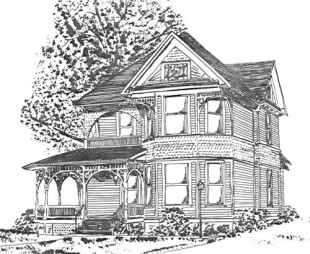
30.13:
The First Thomas Donald Home (Artistic drawing
from
The Badger Collection Featuring Lincoln of Illinois, 1987)
|
|
The first Donald
house survives and is represented in The Badger Collection Featuring Lincoln of Illinois,
1987, (30.11) with the following description:
"Queen Anne,
1880-1910 -- spindle work. . . identifying features. . . hipped roof with
lower cross gables. . . wraparound porch. . . turned porch supports. . .
decorative wood shingles in the gables. . . horizontal band of wood shingles
between floors. . . second story porch. . . cutaway bay windows with
brackets. . . clapboard siding with corner boards. . . ."
|
|
The
Latham Home
William
Maxwell describes the Latham house at right: "facing the Christian
Church in Lincoln, across that little park with a bandstand in the center of
it, was the white clapboard mansion of the Honorable Robert B. Latham.
I remember it was
a very beautiful old house with slender posts supporting the upstairs
porches, shutters at all the windows, wooden balustrades here and there, and
a cupola. . . .
The second generation of
his descendants went through their inheritance so fast that gossip could
hardly keep up with them, and in the early 1920s his house was sold to a
real estate developer, a golfing companion of my father's, who tore it down
and put up a row of semi-identical bungalows" (Ancestors, pp.
300-301).
|
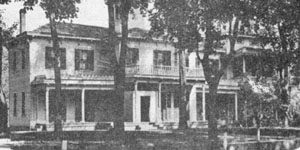
30.14:
The Robert B. Latham Home
North Kickapoo and Delavan
Streets across from Latham Park (19th-Century, demolished, site of
historical marker).
(Photo in Gleason, Lincoln:
A Pictorial History, p. 16)
|
|
The D.H. Harts, Sr., Home
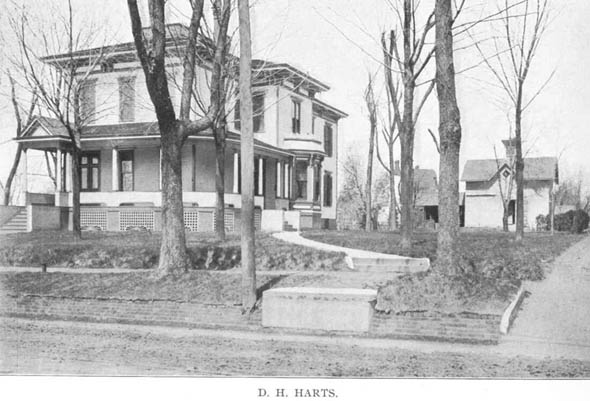
30:15:
Home of D.H. Harts, Sr., on Eighth Street, Where William Maxwell as a Child
Picked Violets
(Photo provided by Dave Johnson, LCHS Class
of 1956)
I have
several publications on the history of Lincoln, Illinois, but had never
seen a photo of the residence of D.H. Harts, Sr., and was unaware that one
even existed until Dave Johnson emailed me to say he had found an old
publication in his basement that contained numerous photos of buildings and
houses in Lincoln. I was pleasantly surprised to find the book
contains the above photo, which Dave was kind enough to email me.
The book with this photo was published in 1903 by the Lincoln Woman's Club
and is titled simply Views. A close look at the full-sized
photo shows streetcar tracks, and several sources verify that the streetcar
did indeed run on Eighth Street from Union to College Street.
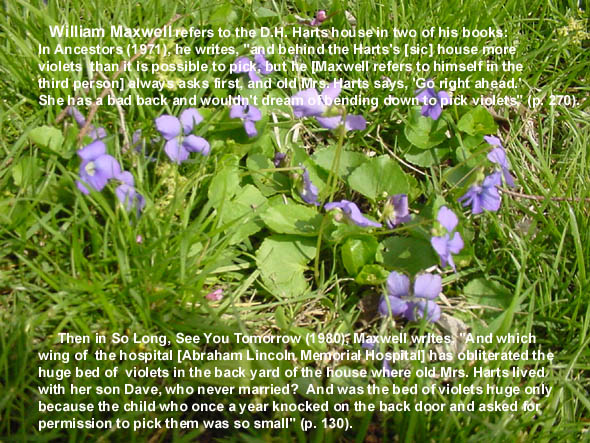
30.16: William Maxwell's
References to the
Home of D.H. Harts, Sr., in Ancestors and So Long, See You
Tomorrow
(Photo of Ozark violets in Leigh
Henson's backyard in Springfield, MO, 4-03)
Note:
David H. Harts, Jr., did eventually marry later in life (his 50s, I
believe). He married Florence Johnson, who taught music at Lincoln
College. Mr. and Mrs. Harts are seen in a photo at
34. A Tribute to the Historians
and Advocates of Lincoln, Illinois. D.H. Harts, Jr.,
lived in a grand old house on Tenth Street, and as far as I know that house
remains. More information about D.H. Harts, Sr., and D.H. Harts, Jr., is
presented at
16.
The Foley House: A
Monument
to Civic Leadership (on the National Register of
Historic Places).
|
|
The Brainerd Home
The Brainerd home is cited in William Maxwell's "With Reference to an
Incident at a Bridge." In that story, Maxwell
describes Lincoln College biology Professor Chris Oglevee as his Boy Scout troop leader and
mentions that Oglevee lived in the Brainerd mansion and was like a son to Mrs.
Brainerd (All the Days and Nights,
p. 266). This picturesque house "was often used for social
gatherings of the Lincoln community and college" (Lindstrom and Carruthers,
Lincoln: The Namesake College, p. 75).
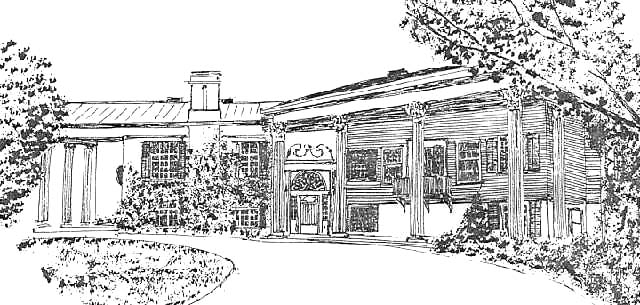
30.17:
Artistic Drawing of the Former Brainerd Home by David Alan Badger
(From The Badger Collection Featuring
Lincoln of Illinois, 1987)
The Brainerd
house survives. Artist-Author David Alan Badger describes the Brainerd
mansion (elliptical periods his): "Construction began in 1874. . . the
house was originally a square, hipped roof Italianate style home. . .
additions & remodelings were made during the 1880s & 1890s. . . the pillars
came from the old Springfield Marine Bank. . . this was the home of Benj. H.
& Ella (Williams) [sic] Brainerd. . . he was a large real estate owner in
Logan & Sangamon Counties. . . also, he was involved in banking under the
name Brainerd & Duston. . . he aided in organizing the Lincoln National
Bank.
Identifying features. . . front gable that crosses into a
low-pitched hipped roof. . . fluted, classical columns with Corinthian
capitals. . . broken, pedimented entry with a fanlight & sidelights. . . (The
Badger Collection Featuring Lincoln of Illinois, no page numbers used).
|
|
The John Dean Gillett Hill Home
John Dean
Gillett Hill was one of the two best friends of William Maxwell's father.
John D.G. Hill is favorably described in Maxwell's short nonfiction
narrative titled "My Father's Friends' (1984). Maxwell admits the
he never had a conversation with Hill until after his father's death in 1958
and then was surprised to find that Hill was an intelligent and appreciative
reader of books. Hill said that what interested him was "what he [the
writer] is carefully not saying, or saying and doesn't know that he is. What his real position
is, as distinct from the stated one. It keeps me amused. All
forms of deception are entertaining to contemplate, don't you find?
Particularly self-deception, which is what life is largely made up of" (p.
272).
In
Ancestors: A Family History (1971), William Maxwell describes the
fishing expeditions of his father, Mr. Hill, and another friend during their
retirement years. My guess is that the setting was Lincoln Lakes.
"Dean Hill had a bad heart and wasn't allowed to row the boat, my father was
more than half blind, and the third man was deaf as a post. They took
a humorous pleasure in compensating for one another's physical deficiencies.
When my father had a bite but couldn't see that his cork was bobbing wildly,
the other two would cry, 'Bill, you've got something on your line!'
And when this crisis was passed, out would come the pint of whiskey.
Sooner or later, the conversation always got around to a subject that both
Dean Hill and my father loved to talk about -- the Gillett family lawsuit" (Ancestors,
p. 158).
This lawsuit
concerned the Gillett family's dispute over the inheritance of millions of
dollars from the vast agricultural empire that had been built by John D.
Gillett, one of the founding fathers of Lincoln, Illinois. This
dispute is an interesting story within the story of Maxwell's own family,
and I suggest you would enjoy reading this material and other accounts in Ancestors.
As an attorney and
businessman, Mr. Hill "was associated with the Logan County Title Company,
the Lincoln Savings & Loan, the Decatur Gravel Company. . . " (Badger,
The Badger Collection Featuring Lincoln of Illinois, no page).
(For information about the Logan County Title Company, see 19.
Business Heritage.)
Mr. Hill was instrumental in helping with the repurchase of the Postville Courthouse site that prepared the way for the construction of its
replica in 1953. For an account this public service activity, see
2.
The Story of
the Postville Courthouse Replica,
Tantivy, & Memoir of the Postville Park
Neighborhood in the Route 66 Era. Mr. and Mrs.
John Dean Gillett Hill lived in a distinctive house in one of Lincoln's
traditional neighborhoods. (According to Badger, their house allegedly
was the first in Lincoln to have a basement dug by a "bulldozer.") The
Hills' house was one of two that his mother, Mrs. Katherine Gillett-Hill,
and he built. She was a daughter of one of Lincoln's founding fathers,
John D. Gillett. Irendean was the name given to the house John Dean Gillett
Hill and his wife lived in. Irendean is a compound of his name and that of his wife, Irene (Harris) (Badger, no
page numbers used). The adjacent house, also with Spanish design, was named Suma Ray, meaning
"perfect peace" in Spanish. It was built by Mr. Hill's mother,
Mrs. Katherine Gillett Hill. Later, Suma Ray was the home of Lemira Gillett
Hunt McClure.
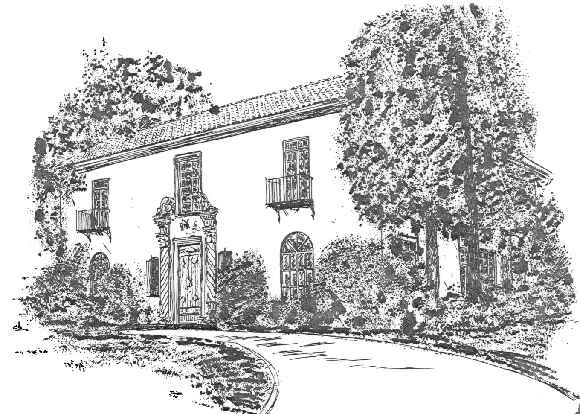
30.18: Artistic Drawing
of Irendean by David Alan Badger
Irendean survives. In his book of artistic drawings, David Alan Badger depicts and describes Irendean and Suma Ray. He identifies the architectural style of both
as
"Spanish eclectic," a popular style from 1915 to 1940 (The
Badger Collection Featuring Lincoln of Illinois, no page numbers used).
Originally, "both houses were pink stucco with blue tile roofs."
An article titled "Twenty Homes Featured on Local Tour" in
lincolndailnews.com (May 8, 200) dates the construction of Irendean and Suma
Ray to about 1927. "The balustrades and entrance door pillars were
carved on-site and designed to match the interior fireplaces."
Badger summarizes Irendean's "identifying
features [as]. . . low-pitched tiled roof. . . double-sash door which opens onto
balconies. . . ornamental iron window grilles. . . broken, pedimented door
surround. . . spiral columns. . . ."
The entrance and fireplace of Irendean were the
work of master stone carver Joseph Petarde of Peoria, Illinois.
Petarde was a vigorous craftsman whose work survives in Peoria (e.g., St.
Peter's Church, G.A.R. Building, and numerous monuments in Springdale
Cemetery) and such other central Illinois cities as Bloomington (Illinois
Wesleyan School of Music, harp and violin designs), Champaign (Huff
Gymnasium), Normal (old gym at Illinois State University), and Springfield (entrance building at
the Illinois State Fairgrounds). "He might have disappeared from
memory except that his house attracted newspaper writers and photographers
when it was first completed in 1922. At that time the neighbors were
shocked and angry about the semi-nude figures at the porch corners, but
gradually they became accustomed to it." In Lincoln, one other
work by Petarde is a seated cat at a house once owned by Jack Harrison --
wherever that was/is. (Adelaide N. Cooley, "Joseph Petarde, Immigrant
Stonecarver," Outdoor Illinois, May, 1977, p. 39).
The
Home of John Dean Gillett Hill's Mother, Mrs. Katherine Gillett Hill
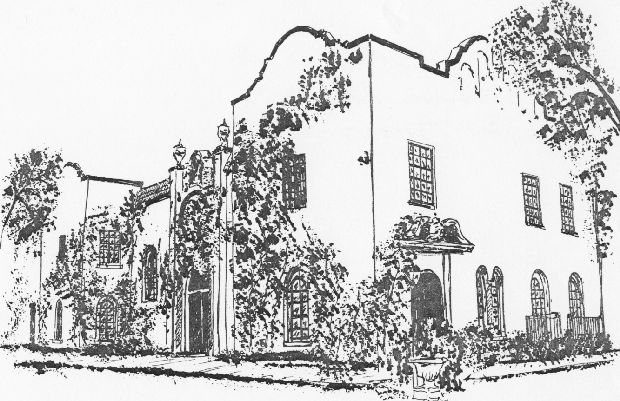
30.19: David Badger's
Artistic Drawing of Suma Ray
Badger summarizes Suma Ray's "identifying features. . . parapeted walls with
coping. . . casement windows with round arches. . . walls clad with stucco.
. . the doors and windows are emphasized by spiral columns. . . decorative
window grilles of iron. . . broken, pedimented entry. . . this
style is rarely found outside of Florida & Southwestern United States. . .
."
Irendean and Suma Ray are just two of many
remaining historic houses that people enjoy seeing when they drive through Lincoln's traditional neighborhoods.
Historic houses of various styles may be observed -- Craftsman, Greek Revival,
Italianate, Second Empire, Spanish, Tudor, and Victorian.
Joseph Petarde's Art That Eventually Played in Peoria (but would it ever
in Lincoln, Illinois?)
The work of stone carver Joseph Petarde on Irendean and Suma Ray helps
to make them two of the most architecturally distinct structures in Lincoln.
My curiosity about Petarde led me to search for the home he built for his
family in Peoria, Illinois. It took me a while to find the house in a
working class neighborhood, but I was happy when I did, and in 2003 I took these
photos with permission of the owner (a Petarde descendant). The owner told
me that various scholars of architecture, art, and photography have made
similar requests over the years.
|
|
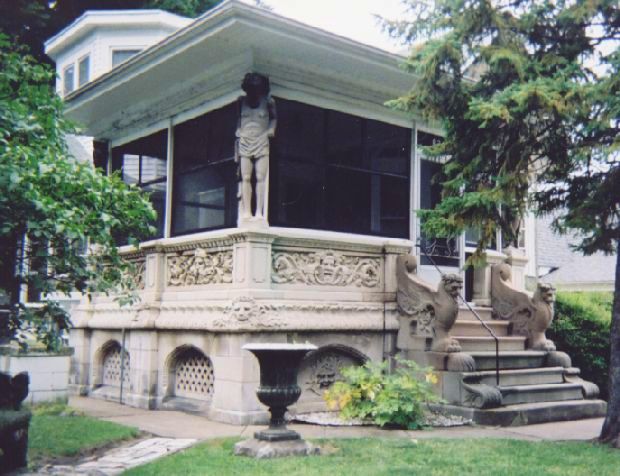
30.20:
Atlass's Hands Hold Up His Loin Cloth While His Shoulders Support the Porch
Roof
|
|
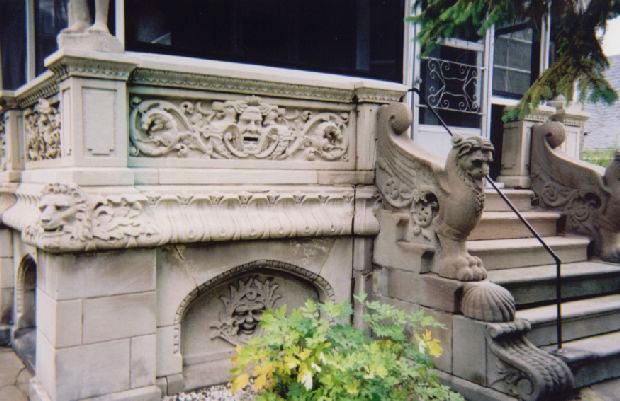
30.21:
Front Porch
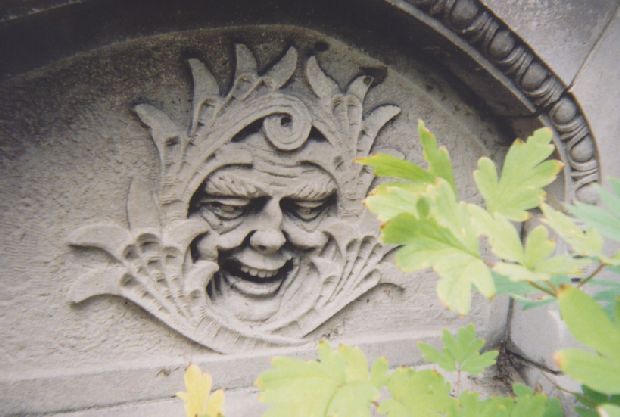
30.22:
Front Porch Detail
|
|
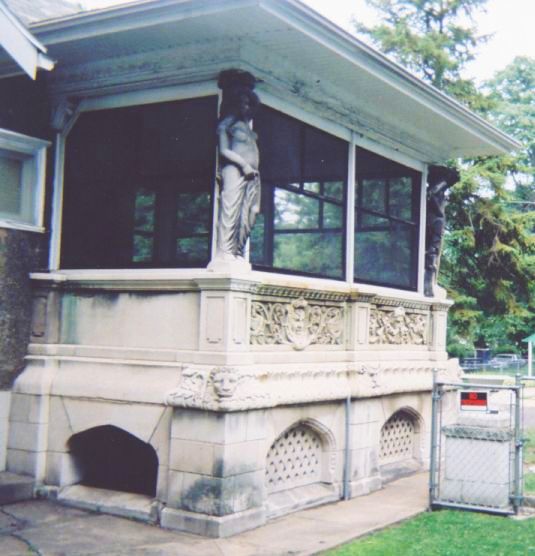
30.23:
Semi-Nude Female on the Side of the Front Porch
Note: Mr. Petarde was attempting to be discreet because
his semi-nude ladies are not conspicuous from the street.
|
|
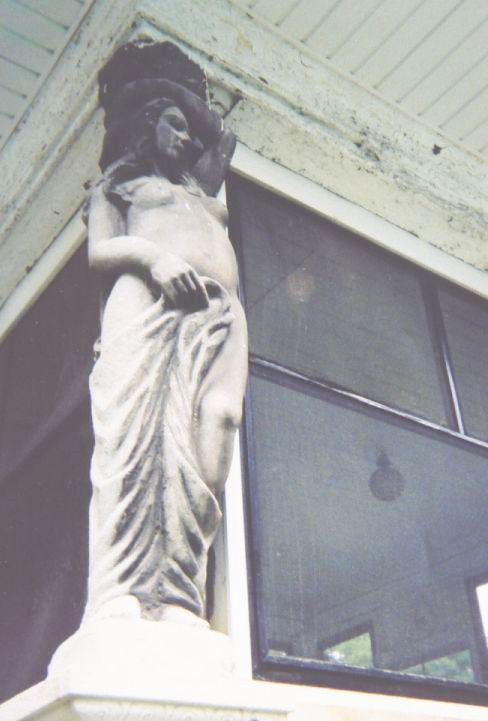
30.24:
Semi-Nude Closeup
|
|
Sources
Cited Badger, David Alan. The Badger
Collection Featuring Lincoln of Illinois. Privately published,
1987. Mr. Badger's material is copyrighted with all rights reserved.
Use of his material in this Web site is with his permission. Please
visit his Web site at
www.davidalanbadger.com.
Burkhardt, Barbara.
William Maxwell: A Literary Life. Urbana, IL: The University of Illinois
Press, 2005. For information about this well-researched biography, including
how to order it, see
http://www.press.uillinois.edu/s05/burkhardt.html.
Cooley, Adelaide N. "Joseph Petarde, Immigrant Stonecarver," Outdoor
Illinois, May, 1977. Gleason, Paul. Lincoln,
Illinois: A
Pictorial History. St. Louis, MO: G. Bradley Publishing, 1998. Material from Mr. Gleason's books is copyrighted with all rights
reserved. Mr.
Gleason's material used in this Web site is with permission from the G. Bradley Publishing Company, 461 Des
Peres Road, St. Louis, MO 63131. Call 1-800-966-5120 to inquire about purchasing Lincoln,
Illinois: A Pictorial History (1998) (200 pages of rare photos and text) or Logan County Pictorial History
(2000) (also 200 pages of rare photos and text). Visit
http://gbradleypublishing.com/.
Historic preservation in Lincoln, Illinois:
http://archives.lincolndailynews.com/2001/May/19/News_new/today_a.shtml
Maxwell, William. Ancestors: A Family History. NY:
Vintage Books, 1971.
__________ . "My Father's Friends." All the Days and Nights:
the Collected Stories. NY: Vintage Books, 1995.
William Maxwell's works are available at
www.amazon.com and
www.barnesandnoble.com.

|
|
Email comments, corrections, questions, or suggestions.
Also please email me if this Web site helps you decide to visit Lincoln,
Illinois:
[email protected]
|
|
"The Past Is But the
Prelude" |
|
 |
|
 |
|



























